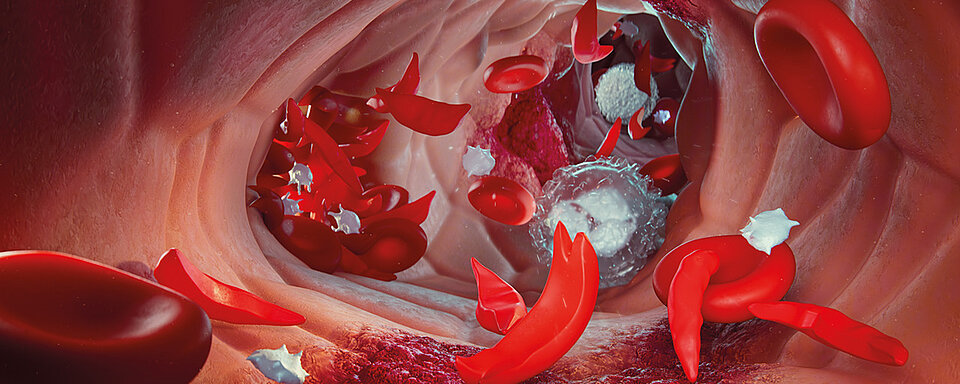Scientific Calendar June 2023
Why not conduct a sickle cell disease screening test on the spot – right after birth?
What is the likelihood that a child will inherit the sickle cell trait, if one of the parents has sickle cell disease and the other is completely unaffected?
25%
50%
75%
100%
Congratulations!
That's the correct answer!
Sorry! That´s not completely correct!
Please try again
Sorry! That's not the correct answer!
Please try again
Notice
Please select at least one answer
Scientific background
If one parent has sickle cell disease (SS) and the other parent is completely unaffected (AA), their child will inherit the sickle cell trait (AS) with a 100% likelihood. In our scenario, the parent with sickle cell disease (SS) will pass on the sickle cell gene (S) to the child, and the unaffected parent will pass on a normal haemoglobin gene (A). As a result, the child will inherit one sickle cell gene (S) from the affected parent and one normal gene (A) from the unaffected parent, resulting in the sickle cell trait (AS genotype). In case the one parent has normal Hb genes (AA) and the other has sickle cell disease due to sickle cell haemoglobin C compound heterozygosity (SC), there would be a 50% likelihood for the child to inherit a sickle cell trait.
Therefore, newborn screening for sickle cell disease is important because it allows for early detection and timely intervention. Early identification of affected infants enables the clinician to implement interventions and regular monitoring to prevent and manage complications associated with sickle cell disease. It also allows for genetic counselling and education for parents about the condition and its management.
Sickle cell disease can be diagnosed through various methods, including newborn screening: Many countries have implemented newborn screening programmes to identify infants with sickle cell disease shortly after birth. This involves collecting a small blood sample from a heel prick and testing it for the presence of abnormal haemoglobin associated with sickle cell disease.
Silverlake Research has developed a simple and easy-to-use point of care test, HemoTypeSC™ that provides point of care determination of haemoglobin phenotypes HbAA (normal), HbSS and HbSC (sickle cell disease), HbCC (haemoglobin C disease), and HbAS and HbAC (carrier or trait).
It is important to note that the sickle cell trait (carrying one copy of the sickle cell gene) can also be identified through this screening method.
References
[1] Charles T. Quinn et al (2016): A rapid, inexpensive and disposable point-of-care blood test for sickle cell disease using novel, highly specific monoclonal antibodies: Br J Haematol. 2016 November; 175(4): 724–732.
[2] Jeannette Bassimbi´e Kakou Danho et al. (2021): Feasibility Study of the “HemoTypeSC” Test for the Rapid Screening of Sickle Cell Disease in Cote D’Ivoir: Hindawi, Advances in Hematology, Volume 2021.
[3] STEELE C et al. (2018): Point-of-care screening for sickle cell disease in low-resource settings: A multi-center evaluation of HemoTypeSC, a novel rapid test. Am J Hematol:1-7.
[4] To the Editor: NANKANJA R et al. (2019): HemoTypeSC demonstrates >99% field accuracy in a sickle cell disease screening initiative in children of Southeastern Uganda. Am J Heatol: 1-9.
[5] NNODU O et al. (2019): HemoTypeSC, a low-cost point-of-care testing device for sickle cell disease: Promises and challenges. Blood Cells, Molecules and Diseases 78:22-28.
[6] MUKHERJEE M et al. (2020): Multicenter evaluation of HemoTypeSC as a point-of-care sickle cell disease rapid diagnostic test for newborns and adults across India. Am J Clin Pathol 153(1):82-87.
[7] NNODU O et al. (2020): Implementing newborn screening for sickle cell disease as part of immunisation programmes in Nigeria: a feasibility study. Lancet Heaematol 7:e534-40.
[8] Comment STREETLY A (2020): Screening infants for sickle cell disease in sub-Saharan Africa: starting the journey to a sustainable model in primary care. Lancet Haematol 7:e503-4.
[9] MCGANN P et al. (2017): The pressing need for point-of-care diagnostics for sickle cell disease: A review of current and future technologies. Blood Cells Mol Dis 76:104-113.

